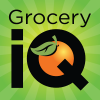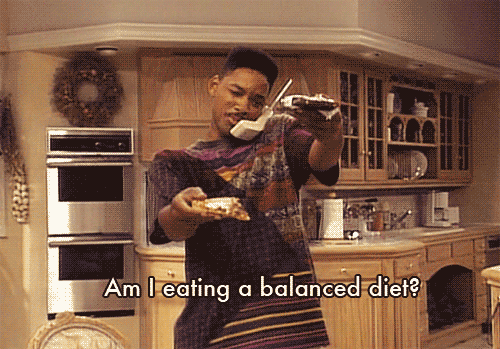▼December 3rd, 2014
How to Actually Stay on a Budget
One of the trickiest parts of striking out on your own is sticking to a budget. No mom or dad to say no to buying Otis Spunkmeyer muffins, Doritos, Blue Bunny ice cream, and loaded potato skins all at once! HAHAHA! But not only will you puke, you’ll be stuck living off of peanut butter toast for the last half of the semester.
Living on a budget doesn’t mean you can’t really live, it just means being smart about what you’re buying.
1. Set a limit.
Everyone’s financial situation is different, so set an amount that works for you. Asking someone more experienced with budgets can be a big help if you have no idea where to start.
Map out what you can comfortably spend on groceries each week, and then set your budget a little bit lower than that; maybe by five or ten dollars. That way you allow yourself a little bit of wiggle room (*ahem* emergency Snickers ice cream bars).
2. Make a list.
Making a list will give you a mission, and keep you from wandering and picking up whatever looks good. Planning ahead will help prevent you from buying a cartful of things that don’t go together.
3. Plan One "Big" Thing
Find a recipe that looks appetizing and not too complicated, and add the ingredients to your list. A lot of people will tell you to downsize the recipe, but unless the recipe is really huge (12 or more people), don’t. Having all those extra servings gives you several meals for the next few days, and the only additional cooking you have to do is throw it in the microwave.
4. Get some "small" things.
Don’t worry! I knew you’d get sick of those leftovers. In addition to your “big” thing, get some easy meals as well: pasta, ramen, frozen fish filets, PBJ supplies. Try to include a couple of food groups as well—steam some frozen veggies in a Tupperware container, get whole wheat pasta instead of regular, toss in some baked frozen chicken you’ve cut up. This will give you a variety of flavors, as well as keep you pretty healthy.
5. Splurge now and then.
Finally, I am definitely not going to tell you to cut out things like ice cream or cookie dough. You and I both know these things are necessities. Treat yourself to one or two things every week. We need to enjoy our high metabolisms while we have them.▲
Image licensed under Giphy.com's Terms.
▼December 2nd, 2014
Do I Wanna Know?
What's Really In Ramen Noodles
We know ramen is definitely not good for us, but we accept it and love it anyway. However, there’s that small part of us that wonders what we’re actually eating when we make ramen, but we hurriedly shush it because we’re hungry and broke. But, I’ve decided to let that small voice have its day, and researched what those delicious steaming noodles are made of.
Oodles of Noodles
I’m focusing on the Chicken Ramen Noodles from Maruchan, simply because that’s my favorite type. I started with the ingredients—and there are a lot of them. The first on the package is “Enriched wheat flour,” which is followed by a set of parentheses stuffed with strange, science-y words. However there’s nothing to really be concerned about here. These ingredients are mostly vitamins and nutrients added to the flour to replace what’s lost when the most perishable part of the wheat is removed to improve shelf life. This processed stuff is not great for you, but it won’t really hurt you either [x].
Next is the vegetable oil and a list of preservatives added. The first, TBHQ, is the most controversial. Some have even called it “lighter fluid,” because TBHQ contains a compound also found in butane [x]. The truth is that while TBHQ is not great for you, you would have to eat a gargantuan amount of ramen to actually be affected by it. The rest are spices and salts, which I’ll talk more about later.
The Soup Base Is Where It's At (The Problem, That Is)
Now we move to the soup base ingredients. It starts with salt and the flavor enhancer monosodium glutamate (MSG). It gets added to a lot of soups, processed meats, and Chinese foods (though ramen is actually Japanese). The FDA has gotten a lot of reports of mild short-term effects of MSG over the years, but researchers haven’t been able to find a definitive link [x]. While the next ingredients, hydrolyzed corn, wheat, and soy protein, don’t sound good to me, many people in the fitness world take them as dietary supplements. They’re even used to make hypoallergenic baby formula. “Hydrolyzed” is a process by which the corn, wheat, or soy is broken down into its amino acids via a strong acid or enzymes to make it more easily digestible [x]. If babies and athletes eat it, then I suppose it’s not a cause for concern.
Maltodextrin is another additive with a strange name but harmless effects. It’s derived from potatoes, corn, or rice, and is used to thicken a product without affecting the taste. Athletes sometimes use maltodextrin for a carbohydrate boost [x]. The next few are nothing to be concerned about; they’re just some spices and dehydrated vegetables. And then we come to a grinding halt at “powdered cooked chicken.” I can let the “powdered” thing slide, because powdered chicken is used in a lot of broths [x]. But I have to wonder what sort of state the chicken was in before they powdered it. I’m thinking of that pink sludge that McDonald’s used to use (“used to”) for their chicken products. I couldn’t find anything about where Maruchan gets their chicken, so this question will have to be left troublingly unanswered.
Even more troubling is the ingredient named only “natural flavor.” It could really be anything. Lanolin is a natural ingredient extracted from sheep sweat that's used in beauty products [x], and castoreum is a natural flavor taken from beaver urine [x]. So who knows what this particular “flavor” is.
Salt, Salt, and More Salt
Aside from that disgusting fun fact, the greatest worry you’ll find for your health in ramen is the sodium content. There are seven different kinds of sodium used in ramen, and in high amounts. But the packaging makes you believe that it’s not as bad as it really is.
They say the serving is half an individual package; meaning half the block of noodles and half the seasoning packet. I don’t know anyone that breaks their noodles in half and puts them in a baggie with their half-used seasoning packet to save it for later. So we can go ahead and double those nutrition facts. Those 830 mg and 35% of your Daily Value of sodium listed on the package jump to 1660 mg and 70% of your Daily Value. Ingesting too much sodium can lead to an increased risk of high blood pressure, stroke, kidney problems, and osteoporosis [x]. In the short term, too much sodium can make you dehydrated, which can lead to a bunch of unpleasant symptoms: dry mouth, dizziness, constipation, lightheadedness, headaches are among the potential annoyances [x].
Should You Kick the Habit?
If you’re like me, you’re having this strange reaction where you are 100% aware of how gross and unhealthy this is as you aggressively scarf down your fourth bowl of the week. But I think that making some changes for the sake of your sodium intake is a good idea. Substituting regular pasta with toppings/sauce or some other quick dish every now and then, or using less than the entire seasoning packet are two options. Accompanying your ramen with a tall glass of water will help as well. Because even though it doesn’t really do anything helpful except shut our stomachs up, I think ramen is too affordable, too easy, and too tasty to give up completely.▲
Images licensed under Creative Commons.
▼December 1st, 2014
Product Review: Mr. Coffee Iced Tea Maker

How It Works: It’s exactly like a coffee maker. Pour about three quarts of water (the pitcher has markings) into the tea maker, replace the brew basket and add your tea bags or coffee filter and tea leaves, select strong or mild along the slider, place the pitcher in its slot, and push the “BREW” button. In a couple of minutes, your tea is ready, and the tea maker shuts itself off automatically.
Why It's Useful: First and most importantly: tea contains caffeine, and we are college students. Perhaps you don’t care for coffee, or would like an alternate beverage to mix things up. This makes a big pitcher all at once, with minimal effort, so you can have tea for days (although it may vary according to the proximity of exams). It’ll also help you save your Dining Dollars or Flex, as one pitcher costs less to make than one cup of anything from Starbucks or Dunkin’ Donuts.
Reviews: I was surprised to learn that this tea maker actually received very poor reviews from consumers. It received its lowest reviews on the Mr. Coffee website, getting an overall rating of 1.6 out of 5 stars, with almost every review complaining of leakage. Amazon users voted similarly, giving it an overall rating of 2.2 out of 5 stars, with the same complaint but sassier language. However, on Kmart’s website, it received an overall rating of about 4.5 out of 5 stars, with most of the complaints again being related to leaking. Positive reviews said that it was easy to use and made great tea.
Best Price: $17.99 (+shipping and tax on Mr. Coffee’s website)
My Final Opinion: We’ve had one in my house for at least a year now, and I can only think of one time when my tea maker leaked, and it didn’t make a huge mess. An annoyance, definitely, but not “tea-rribble” (I couldn’t resist, credit goes to G.C. on Amazon.com). It’s not the best tea I’ve ever had, but it’s still good. My favorite thing about this product is simply the ease of use. I like that I can set it up, walk away, and come back to a huge pitcher of tea. Combined with the low price, I feel this product earns a solid rating of 4/5 stars.▲
Mr. Coffee
Kmart
Amazon
Image source here.
▼November 30th, 2014
Nutrition 101
I wasn’t terribly concerned about eating healthy until I joined a dance team last year, and I learned that eating healthier really does make you feel better after a while. But a lot of the health blogs and Pinterest pins I see show complicated dishes with a dozen unusual ingredients—I don’t have the time, funds, or patience most days to cook things like that. Instead I take a more basic approach to food that still keeps me pretty solid on my daily vitamin and nutrient quotas.
Food Groups
Yeah yeah I know, food pyramid, high school health class—we’ve definitely heard it all before. But don’t worry, we’re keeping it simple. For each meal, what you’re aiming for is:
- A protein. This could be peanut butter, eggs, chicken, fish, or beans.
- A fruit or vegetable. Fresh produce is great and all, but it’s so needy. Frozen stuff totally works.
- A grain. Rice, bread, pasta, oatmeal all count. Whole grains will have more fiber and nutrients.
- A dairy product. Cheese, milk, and yogurt give you the calcium you need.
Limiting the Bad Stuff
I’ve said before that I’m definitely not one to tell you that you need to cut junk food out of your life. There’s nothing wrong with doing that, and there’s also nothing wrong with bacon cheese fries dipped in ranch. Just have a good control over the amount of junk food you eat. One way to do this is just not keeping a lot of snacks in your apartment. If you don’t have chips in the pantry, then you can’t eat the whole bag in one episode of The Walking Dead. Order Chanello’s or Chinese food, just not every time you think about it. Trade tea, water, or juice for soda now and then. Eating healthy doesn’t have to be an enormous life change, it just means mixing things up a little bit.▲
Image licensed under Giphy.com's Terms.
▼November 28th, 2014
There's an App for That
Grocery App Testing
They really do make an app for almost everything. Some simply elicit the response of “…why?” but others are pretty useful.
I looked at six different grocery-related apps, picked from lists on PopSugar and About.com. I chose these apps based on how potentially relevant and useful I saw them in helping to manage grocery- and food-related needs as a student.
 Grocery IQ
Grocery IQ
This app is designed to be like a virtual grocery list, but with a lot of extra features. It automatically organizes your grocery items by type: beverages, bread, breakfast & cereal, dairy, eggs & cheese, etc. The categories reflect what sort of things are usually put together in the grocery aisles. Not all stores put their aisles in the same order though, so Grocery IQ lets you put categories in the order that they appear in your store, making things even easier to find. You can check things off your list as you pick them up with just a tap, and the app logs a history of what you buy.
Grocery IQ also boasts in-app coupons, but they were few to be seen. It also allows you to scan barcodes of items, but the scanner is not native—you have to download a separate barcode scanner app if you don’t already have one. Plus, when you scan the items, it only identifies the item—it doesn’t tell you the price, which to me makes that feature superfluous. Grocery IQ also has a store locator, but unless you only like to grocery shop in unfamiliar areas, I don’t see the use of that.
Pros:
- Great grocery list functionality
- Easy to use
Cons:
 Ziplist
Ziplist
Ziplist has similar grocery-list-making functions of Grocery IQ—it sorts things in the same categories, and you can check things off as you buy them. What makes it different are the “Items You May Need” and “Recipes” tabs. The app has a list of common grocery items that you can add directly to your own list; useful in case your forget something. My favorite feature is the “Recipes” tab. There are a ton of in-app recipes to choose from, but you can also add any recipe you find on the internet to Ziplist via the “share” option on the website. Ziplist reads what the ingredients are, and puts them directly into your list! You can add any amount of recipes to your “Recipe Box.”
Pros:
- Another great grocery list app
- Import recipes from anywhere and save them for later
- Recommends items you may need
Cons:
- Not as many grocery list features
- In-app recipes include no up-front indication of difficulty
 Locavore
Locavore
This app is specifically for helping you find in-season, locally grown food. I was excited to try it out, but I couldn’t get past the “Create a Profile” page! The buttons stopped responding, and I wasn’t able to enter my location. When I tried again some time later, it froze up even sooner. This is a really neat idea for an app, and I hope the creators are able to fix whatever bugs that have come up.
 Grocery Pal
Grocery Pal
The premise for Grocery Pal is letting you know what deals are available at stores near you. You enter your zip code, and it finds stores near you. From there, you select which stores you want it to track. It also has a grocery list function like Grocery IQ and Ziplist.
I tested out the price comparison feature by checking out milk prices. What came up in the search were a lot of milk-related products, only one of which was actually milk. Additionally, the app only showed me products that were on sale, not regular priced items, and not the prices from all the stores on my list. So there was literally nothing to compare. Even if I had this pulled up on my phone in the store, I’d probably just pay the extra few cents for the product in front of me, rather than driving all the way to another store. Irrelevant kid-related items also conveniently appear in every search. I’m sure it’s just a bug.
Pros:
- Another good grocery list app
Cons:
- That's the only thing that works
 Key Ring
Key Ring
Key Ring keeps all of your membership cards in one place. You scan the barcode, add information about where it’s from, take pictures of the original card, and have the option to include a description to further identify your card. And their selection is huge! I found every store or restaurant I thought of—I think you would have difficulty not finding what you need. It can also find existing membership programs near you using your geolocation or zip code, and tell you what sales, deals, and coupons are going on at those places. Key Ring also has a grocery list feature, but it’s much less straightforward than the other apps. You would be better served getting another app for that.
Pros:
- Convenient way to consolidate your membership cards
- Wide selection of stores and restaurants
- Easy to use
Cons:
 Cellfire
Cellfire
Of all the apps I tried, this one was easily the least useful. It’s intended as a coupon app, and was even recommended by one of the sites I visited. Cellfire invites you to “tap the map to see stores in your area”—but it’s literally a map of the United States, with no zoom function. You can also search stores in your current location, but since there are only has 53 total stores on the app, it isn’t very useful. The only two stores that came up in the Harrisonburg area were Kmart and Rite Aid. This one seems more like an app-in-progress; perhaps useful somewhere, but not here.
Most Useful: Ziplist
What put it over the top was the ability to import ingredients from a recipe anywhere on the internet directly into your grocery list, and to save recipes you liked for later all in one place. That’s more useful to me than coupons. While I don’t think its grocery-list-making functions are as quite as good as Grocery IQ, it still works great. I tried it out the last time I went grocery shopping, and I found it faster and easier to use than a typed or written list, especially because of the sorting function. It’s a small change to make, but it can definitely save you some time at the grocery store.▲
Images from here, here, here, here, here, and here.
Click here to return to top.






 Grocery IQ
Grocery IQ Ziplist
Ziplist Locavore
Locavore Grocery Pal
Grocery Pal Key Ring
Key Ring Cellfire
Cellfire